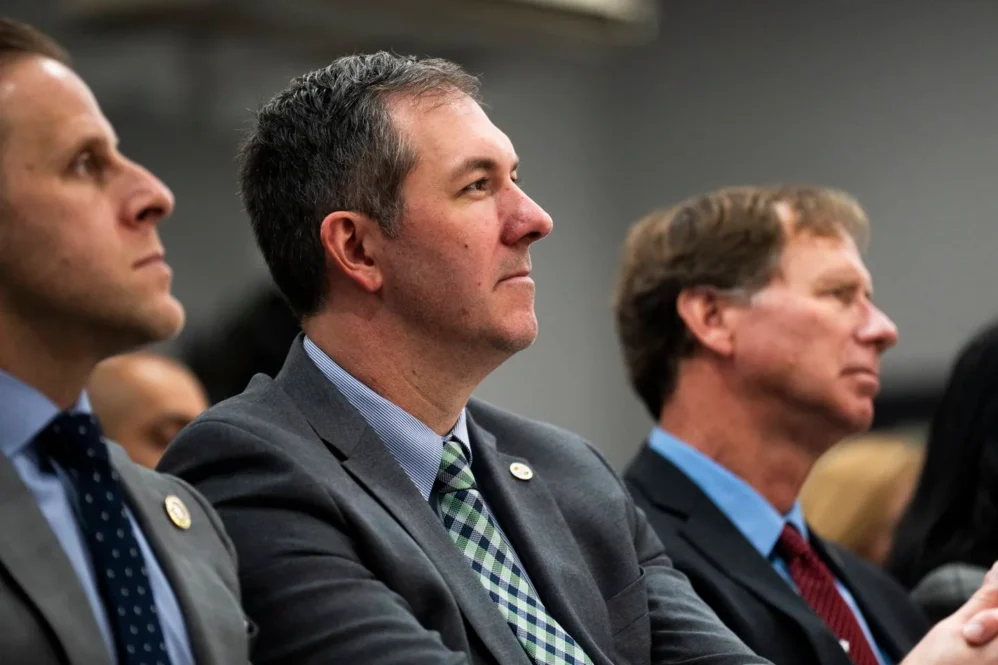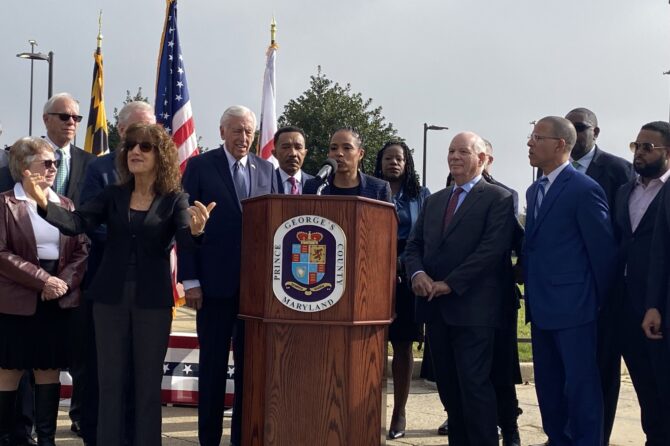BALTIMORE BANNER: Baltimore County Executive Johnny Olszewski Jr. has his sights set on Washington, launching a campaign for Congress on Tuesday.
Olszewski, a Democrat in his second term as county executive, hopes to succeed longtime U.S. Rep. C.A. Dutch Ruppersberger, who announced his plans to retire last week.
“I’m running because I think it’s time that we showed D.C. how to get things done,” Olszewski said in an interview with The Baltimore Banner ahead of his launch. “I’m excited about the prospect of being part of the new generation of leaders in Washington.”
Olszewski kicked off his campaign by releasing an announcement video online, introducing himself by his nickname, “Johnny O,” and pledging that in Congress, he’d work to forge compromise “without compromising our values.”
Olszewski faces company in the race: State Del. Harry Bhandari, a Democrat representing the northeast portion of the county, also intends to run.
Raised in Dundalk, Olszewski now lives on Millers Island — barely outside the current boundaries of the 2nd Congressional District. Millers Island is a peninsula on one side of Back River in the 7th Congressional District, while neighborhoods on the other side of Back River are in the 2nd Congressional District. Before the last round of redistricting, Olszewski’s home was in the 2nd District.
Members of Congress are not required to live in their districts, only in the correct state.
While Olszewski acknowledged he lives “just barely” outside the district, he also said that he already represents and works for residents in a large swath of the district. “I am living in, working in and supporting much of the district already,” he said.
The 2nd Congressional District includes most of Carroll County, as well as a significant section of Baltimore County, including neighborhoods on the county’s west side, the north-central area up to the Pennsylvania line, and reaching across to some northeastern and eastern neighborhoods. It also dips into Baltimore to pick up a few northern neighborhoods.
The shape of the district has morphed over the years through periodic redistricting, and had been represented by Ruppersberger since the 2002 election. Ruppersberger also was a Baltimore County executive before winning election to Congress.
Olszewski, though only 41, has more than two decades of experience in public service, dating back to when he was a high school student member of the county’s school board.
He went on to become a public school teacher and was appointed to fill a vacancy in the House of Delegates in 2006, when he was just 23. He went on to serve until the 2014 election, when he lost a bid to become a state senator. Olszewski parlayed that loss into a win as county executive four years later in 2018. In that election, Olszewski won a razor-thin 17-vote victory in the Democratic primary, before going on to an easy win in the general election.
After winning reelection in 2022, Olszewski’s current term would run through the 2026 election. He serves as president of the Maryland Association of Counties, representing the interests of local governments, particularly on issues being considered by the state legislature.
Olszewski has described himself as a progressive Democrat, and some of his efforts as executive have focused on issues such as climate change, affordable housing and police reform. He says that, as a county executive, he has real-world experience in enacting policies that will prove useful on Capitol Hill.
He created the position of sustainability officer to guide the county’s efforts to combat climate change.
He also created a Department of Housing and Community Development to work on boosting the availability of affordable housing in the county. The housing department was created, in part, to help the county make progress under a 2016 settlement with the federal government over the lack of affordable housing
On housing, Olszewski also made a successful push in 2019 for the County Council to pass a law banning landlords from turning down prospective renters solely because they use federal housing vouchers. A similar law was passed statewide in 2020.
The county executive also put forward policing reforms: banning officers from using chokeholds, adding protections for police whistleblowers, creating an early-warning system for officers at risk of misconduct, and requiring officers to intervene when colleagues use excessive force.
In his tenure as county executive, Olszewski has touted his efforts at improving transparency, including partnering with County Council members to hold community meetings on the budget around the county.
But Olszewski has not won over all of his critics on that front.
He created the county’s first ever inspector general’s office to investigate issues within county government. But after bristling at some of the inspector general’s investigative targets, Olszewski sought to create an oversight board that would have been appointed by himself and the chair of the County Council. Under pressure, Olszewski instead created a “blue ribbon” commission to recommend changes to the inspector general’s office and process.
Olszewski has pursued some of the commission’s recommendations, including clarifying the inspector general’s ability to review records without issuing a subpoena and having voters decide in this year’s election whether to enshrine the inspector general’s office into the county’s charter — effectively making the position permanent.
Some raised concerns when Olszewski named John Vontran, a developer who has faced legal trouble, as an economic development strategist for the county. There also were questions when Olszewski’s father, former Councilman John A. Olszewski Sr., lobbied for a proposed redevelopment project in Middle River — at one point sitting beside the county’s then-economic development director at a hearing in Annapolis. Both father and son said at the time that they were careful to keep their work separate.
Olszewski becomes the immediate front-runner in the race, with advantages including name recognition and a significant fundraising and campaign apparatus. He’s sitting on $1.7 million in a state campaign account — which he cannot use in his congressional race, but offers an indication of his fundraising prowess.
The most politically experienced other candidate in the race is Bhandari, a teacher and immigrant from Nepal serving his second term in the House of Delegates.
Bhandari, 46, had created an exploratory committee with the Federal Elections Commission and decided to run after Ruppersberger announced his retirement.
Bhandari has a compelling life story, growing up poor in rural Nepal before coming to the United States at age 27. He was a teacher and principal in Nepal, and worked at a gas station and later as a substitute teacher before becoming a permanent teacher in Baltimore City schools.
He rose through the ranks of local Democratic politics, door-knocking for President Barack Obama, earning leadership positions with Young Democrats and serving on the Democratic State Central Committee for Baltimore County.
After a narrow loss in 2014, he won a seat in the House of Delegates in 2018. He’s believed to be the first Nepali-American elected to a state legislature in the U.S.
As someone who has lived the “new American struggle” and seen poverty and trauma through the eyes of his students, Bhandari says he’s well-equipped to take his passion for helping the vulnerable to Washington, D.C. He says he will bring “informed, compassionate leadership.”
Bhandari says he’s motivated to serve his adopted country, and thinks he can expand his work in Washington. “When you make a small change, you want to make a bigger change,” he said.
Other Democrats who have filed to run include Jessica Sjoberg and Clint Spellman Jr., both from Baltimore County.
On the Republican side, Dave Wallace from Carroll County has registered as a candidate.










